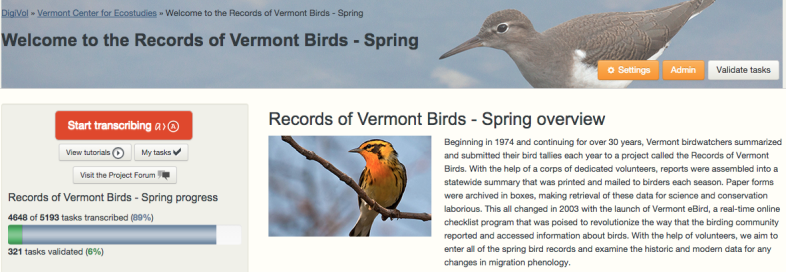
Just over 3 months ago we announced an exciting new web site that allowed us to connect with volunteers virtually to help us enter thousands of historic bird records that only existed on paper and filed away in boxes. We called it the Phoenix Project. You answered our call for help. Volunteers have digitized over 4,600 pages of spring bird records and we’re 90% done.
The final push is on! We need your help in making our goal a reality!
But the rebirth of bird sightings data depends on a dedicated corps of volunteers who, in their leisure time and from the comfort of home, can easily move bird sightings from paper to computer. To make it happen, VCE traveled virtually around the world to team up with the Atlas of Living Australia (ALA), which in collaboration with the Australian Museum has developed DigiVol. DigiVol allows volunteers to view scans of the paper documents online, and convert them on the spot to digital form. From there, VCE will add the records to Vermont eBird, a project of the Vermont Atlas of Life, for use free of charge to anyone — from students to birders to researchers.
Here at VCE, we’re already putting some of the digitized data to use. Since much of those early bird sightings were first collected, the growing season in Vermont has increased by about two weeks. Ice-out on lakes and leaf-out on the lilacs in our front yards come about 12 days sooner. Although the phenology — or the timing of major natural events — varies normally from year to year, on average Vermont springs come earlier. And that could be a concern for bird conservation. As plants and insects emerge earlier in the season, for example, we can analyze whether birds have adequately adjusted the timing of their own migration or breeding cycles to keep pace. A mismatch could cause bird populations to decline.
Visit our DigiVol site where you can register and login. You’ll find a short tutorial to read before getting started. If you have questions or would like to share a neat observation you uncover during your travels through these historic records, there’s even a project forum to post notes to the community.
With the help of volunteers distributed around the world many hands will make light work of science and conservation. Thank you to those of you that have helped us with this massive task.


For some reason I’m unable to access the DigiVol page anymore. Hopefully this means all tasks have been transcribed!
All the data has been entered! We are amazed and thrilled! Thanks for checking in. Kent